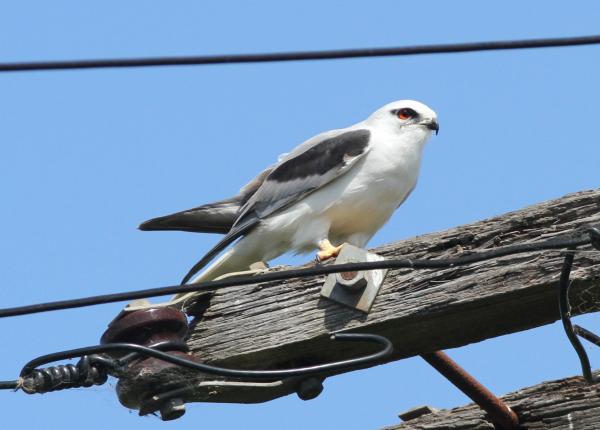Did You Know?
- This species is also known as the Australian Black-shouldered Kite
- Though considered mostly a diurnal species, this kite will sometimes hunt on moonlit nights
- When there is an abundance of food available, the Black-shouldered Kite may have two broods of young per year.
How The Peregrine Fund is Helping
Though The Peregrine Fund does not work directly with Black-shouldered Kites, our efforts in scientific research, habitat conservation, education, and community development help conserve birds of prey around the world. We also supply literature to researchers from our avian research library, which helps scientists around the world gather and share important information on raptor conservation. And, finally, our support of the Global Raptor Information Network gives raptor researchers tools to more efficiently conduct their own studies while contributing to a global program. It also provides citizen scientists a way to participate in raptor science and conservation.
Where They Live
The Black-shouldered Kite is endemic to Australia. It makes its home throughout the island and is a denizen of open country. It can be found in grasslands, wet savannas, sand dunes along the coast, croplands, and open woodlands with tall grass. If you ever find yourself in Black-shouldered Kite habitat, be sure to scan the dead upper branches of a tree, or the tops of power pole, where it sometimes likes to perch.
What They Do
The Black-shouldered Kite is active at all times of the day. It is considered to be diurnal (active during the day), crepuscular (active during right before dawn and after dusk) and it is occasionally nocturnal, too! It roosts, or rests in groups with other kites.
Like the American Kestrel, or other members of this genus, it is able to hover in one spot. When it soars, it holds its wings in a dihedral, which is another way of saying in a "v" shape.
Why They Need our Help
The Black-shouldered Kite is categorized as a species of Least Concern. It is widespread and common throughout most of its range, and over the years, its population has actually increased both in distribution and in numbers. This is likely due to more open areas being created as forests and other habitats are altered, and the introduction of prey animals, such as non-native rodents.
What They Eat
This lovely and graceful kite dines mostly on small rodents, particularly the introduced House Mouse. However it also hunts small birds, lizards, and large insects, such as grasshoppers.
When hunting, it might hover just above the ground, then swoop down to capture its prey, or it might wait patiently on a perch, before dropping to snatch a meal from the ground.
Nests, Eggs, and Young
During courtship, the male and female will engage in some spectacular aerial displays. They spend time circling high in the sky, and will grasp each other's talons and cartwheel down close to the ground before releasing each other and flying up again.
When it is time to build the nest, the pair will work together to gather nesting materials, such as sticks and green leaves. Then, the female will construct the nest in the canopy of a large tree. She will line the nest with green leaves. Sometimes the pair will build the nest far away from other nesting pairs of the same species. However, when there is a lot of prey around, sometimes several Black-shouldered Kites will nest very close to each other in small groups called colonies.
When the time is right, the female will lay between two to five eggs, but it is more common for her to lay three to four eggs. She will do most of the work to care for the eggs. During this time, the male does help with incubation duties from time to time, but his main job is to find enough prey to feed himself and the female. After around 31 days, the nestlings will hatch. The will be covered in soft down, but will grow quickly. In only around 35 days, they will be ready to leave the nest for the first time. Once they are out and flying, they will stay with their parents for another month or so as they learn to hunt and to avoid dangers. After they are one year old, these kites will be able to breed for the first time.
Black-shouldered Kite and the World Center for Birds of Prey
The World Center for Birds of Prey offers fun ways to learn about all birds of prey. Interactive activities, tours, interesting videos, and a children's room with activities from coloring sheets to quizzes to costumes await you. The visitor center has many live raptors on display, and in the fall you can observe some of the raptors showing off their flying skills during our Fall Flight Shows. This is a great chance to see birds of prey up close and learn about the wonderful and interesting adaptations they have in order to survive in their respective habitats. There is also a touch table with feathers and other natural objects available for exploration. Our knowledgeable staff is on hand year-round to answer any questions you may have about the Black-shouldered Kite or any other bird of prey.
References:
Debus, S., G. M. Kirwan, and J. S. Marks (2020). Black-shouldered Kite (Elanus axillaris), version 1.0. In Birds of the World (J. del Hoyo, A. Elliott, J. Sargatal, D. A. Christie, and E. de Juana, Editors). Cornell Lab of Ornithology, Ithaca, NY, USA. https://doi.org/10.2173/bow.auskit1.01
Global Raptor Information Network. 2022. Species account: Australian Kite Elanus axillaris. Downloaded from http://www.globalraptors.org on 5 Apr. 2022









